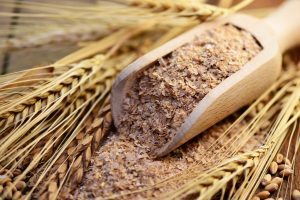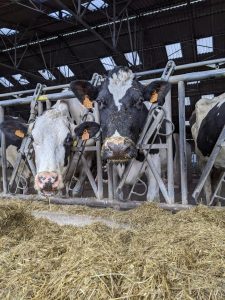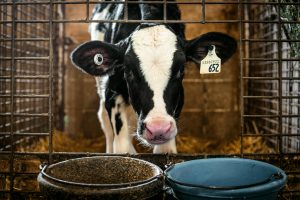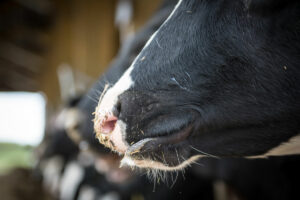Álvaro García
The transition period—spanning the three weeks before calving through the first few weeks postpartum—is one of the most metabolically demanding stages in a dairy cow’s life. During this time, cows undergo dramatic shifts in hormonal balance, immune status, and nutrient requirements. A predictable drop in feed intake just before calving, coupled with rising energy demands for colostrum and milk production, sets the stage for a series of potential health challenges. These include metabolic disorders such as hypocalcemia, ketosis, and displaced abomasum, as well as impaired immune function and rumen instability. Proactive nutritional and management strategies are essential to minimize risk and support a productive lactation.
Periparturient disorders
- Dystocia
- Nerve compression paralysis
- Retained placenta
- Metritis
- Udder edema
Metabolic disorders
- Hypocalcemia
- Fatty liver/ketosis
- Acidosis
- Displaced abomasum
- Laminitis
Preparing the rumen for the postpartum diet
Successfully transitioning a cow’s diet depends heavily on how well the rumen environment adapts. This adaptation includes both microbial population shifts and structural changes to the rumen lining. Introducing modest amounts of concentrate to close-up cows—typically three weeks before calving, or five weeks for first-lactation heifers—stimulates the development of rumen papillae and helps establish microbial communities capable of handling the energy-dense diets of early lactation.
To support this microbial transition, it’s important that the close-up diet closely resembles the lactation diet in composition. Sudden shifts in feed ingredients or nutrient density can disrupt fermentation, lower feed intake, and compromise the cow’s ability to adapt. Strategic feed planning during the transition period is essential to set the rumen up for success.
Rumen health relies on a careful balance between microbial fermentation and physical motility. Disruption of this balance—typically due to diets high in fermentable carbohydrates and low in physically effective fiber—can result in ruminal acidosis, beginning in a subclinical form and potentially progressing to clinical disease.
Effective fiber plays a critical role in promoting rumination and buffering rumen pH. During rumination, saliva—rich in sodium bicarbonate—helps neutralize the acid load generated by fermentation. When particle size is too small or the proportion of starch and sugars exceeds the cow’s natural buffering capacity, acid accumulates, and pH drops.
Inadequate physically effective fiber (peNDF), particularly from finely chopped or micro-processed forages, results in less stimulation of rumen motility and earlier passage of undigested feed. Whole grain in the manure may indicate inadequate grain processing or silage that is too dry, but when accompanied by foam and mucus, it often points to hindgut fermentation and subclinical acidosis. Subclinical acidosis may be further indicated by the following signs:
- 5–10% drop in feed intake
- Lameness (due to laminitis)
- Inversion of the milk fat-to-protein ratio
Key indicators of subclinical acidosis
- Depressed ruminal pH (often <5.8)
- Irregular or reduced rumen contractions (hypermotility or atony)
- Decreased chewing and cud chewing activity
- Fluctuations in daily dry matter intake
Manure observations associated with acidosis
- Wide variation in consistency (firm to watery within the same group)
- Presence of gas bubbles
- Mucus or fibrin strands
- Long, undigested fiber particles
- Visible undigested grains
Supporting blood calcium balance
Achieving and maintaining adequate blood calcium concentration is essential for transition cow health. Calcium plays a vital role in smooth muscle contraction, nerve transmission, immune function, and energy metabolism. Even mild declines in blood calcium—often undetected without monitoring—can compromise feed intake, increase the risk of reduced uterine motility and retained placenta, and contribute to displaced abomasum and mastitis. Subclinical hypocalcemia, which may affect more than half of multiparous cows at calving, has been associated with decreased reproductive performance, higher disease incidence, and reduced milk yield in early lactation.
One of the most effective strategies to enhance calcium homeostasis in prepartum cows involves manipulating the Dietary Cation-Anion Difference (DCAD). This approach consists of adjusting the balance between positively charged ions (cations such as potassium [K⁺] and sodium [Na⁺]) and negatively charged ions (anions such as chloride [Cl⁻] and sulfur [S²⁻]) in the diet. Feeding a negatively balanced DCAD diet during the final 21 days before calving induces a mild compensated metabolic acidosis, which enhances parathyroid hormone (PTH) sensitivity and promotes more efficient calcium mobilization from bone and absorption from the intestine.
To achieve the desired acid-base shift, common practice involves supplementing the close-up diet with anionic salts (e.g., ammonium chloride, calcium sulfate, magnesium sulfate). However, care must be taken to maintain palatability and prevent dry matter intake suppression. The target DCAD for close-up cows is typically between –100 and –150 mEq/kg of dietary dry matter, although specific formulations should account for forage mineral content and cow parity. Routine monitoring of urine pH provides a practical tool for assessing dietary acidification.
DCAD management summary for close-up Cows | |
Parameter | Target range or action |
DCAD level | –100 to –150 mEq/kg dry matter |
Urine pH (after 24 hrs. on diet) | 5.5 to 6.5 |
Potassium content in forages | < 1.8% of dry matter |
Use of anionic salts | Ammonium chloride, calcium sulfate, magnesium sulfate (ensure palatability) |
Diet monitoring frequency | Weekly urine pH checks on 5–6 cows near calving |
Strengthening the immune system during the transition period
The transition period presents not only a nutritional and metabolic challenge, but also a period of increased immune vulnerability. Around calving, hormonal changes—particularly the rise in estrogen and corticosteroids—naturally suppress the function of immune cells such as neutrophils and macrophages. This immunosuppression weakens the cow’s defenses against pathogens and increases the risk of periparturient diseases, including mastitis, metritis, and retained placenta.
One of the less obvious contributors to immune dysfunction is metabolic stress, especially from conditions like subclinical hypocalcemia and negative energy balance. Low blood calcium impairs muscle function but also affects immune cell signaling, while elevated cortisol levels—triggered by energy and calcium deficits—further compromise leukocyte response and inflammatory regulation. Thus, nutritional strategies aimed at preventing metabolic disorders have a direct impact on immune competence.
Ensuring adequate supply of immune-supporting trace minerals and antioxidants is essential in maintaining immune cell activity and oxidative balance during this high-risk period. Recommended daily levels for close-up and early lactation cows include:
- Selenium: 3 mg/day (preferably a mix of organic and inorganic forms to enhance bioavailability and storage in immune tissues)
- Vitamin E: 1,000 IU/day (a critical antioxidant that protects cell membranes and supports neutrophil function)
- Copper: 100 mg/day (involved in white blood cell function and antioxidant enzyme systems like superoxide dismutase)
- Zinc: 400 mg/day (essential for skin and udder integrity, and supports neutrophil migration and phagocytosis)
Supplementing these nutrients through organic sources (e.g., chelates or proteinates) may offer improved bioavailability and more consistent tissue uptake compared to inorganic forms, especially under the stress of transition.
Meeting energy and protein needs to avoid immune suppression
In addition to micronutrients, cows require adequate metabolizable protein and energy to support immune cell production, repair tissues, and mount an appropriate response to infection. Diets for close-up and freshly calved cows should provide:
- At least 1.6 kg of metabolizable protein per day
- Net energy for lactation (NEL) of approximately 1.6 Mcal per pound of dry matter intake
These levels help sustain immune cell proliferation, maintain tissue barriers, and reduce the need for nutrient reallocation from other physiological systems (e.g., mammary gland or uterus) during immune activation.
The transition period demands careful attention to both nutritional management and physiological adaptation in dairy cows. Success during this phase hinges on three critical strategies: ensuring rumen functionality through dietary consistency and effective fiber; supporting metabolic balance, particularly calcium homeostasis, through precision DCAD formulation and monitoring; and strengthening immune defenses with targeted micronutrient and energy support. These components are deeply interconnected—imbalances in one area can compromise the others, leading to a cascade of health issues that affect performance, reproduction, and longevity. By anticipating the cow’s changing needs before, during, and after calving, producers can move from reactive treatment to proactive prevention, setting the stage for a healthier and more productive lactation cycle.
References
National Academies of Sciences, Engineering, and Medicine (NASEM). (2021). Nutrient requirements of dairy cattle: Eighth revised edition. National Academies Press.
Lopreiato, V., Mezzetti, M., Cattaneo, L., Ferronato, G., Minuti, A., & Trevisi, E. (2020). Role of nutraceuticals during the transition period of dairy cows: A review. Journal of Animal Science and Biotechnology, 11(1), Article 96.
Mezzetti, M., Cattaneo, L., Passamonti, M. M., Lopreiato, V., Minuti, A., & Trevisi, E. (2021). The transition period updated: A review of the new insights into the adaptation of dairy cows to the new lactation. Dairy, 2(4), 617–636.
© 2025 Dellait Knowledge Center. All Rights Reserved.









